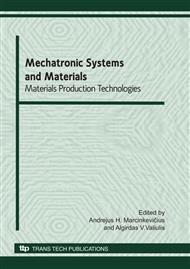p.371
p.377
p.382
p.388
p.394
p.400
p.404
p.410
p.414
Influence of Material Model on Tensile Loaded Joint
Abstract:
The paper deals with the numerical analysis of a tensile loaded riveted joint. Finite element simulations of the upsetting process were carried out with the use of Marc code to determine the residual stress field. The contact with friction is defined between the mating parts of the joint. The computations were performed for four cases of material and load conditions and a comparison was performed on the basis of results obtained for standard elasto plastic and Gurson material models. Moreover, the influence of material model and residual stress on the tensile loaded joint was analyzed.
Info:
Periodical:
Pages:
394-399
Citation:
Online since:
June 2010
Authors:
Keywords:
Price:
Сopyright:
© 2010 Trans Tech Publications Ltd. All Rights Reserved
Share:
Citation:


